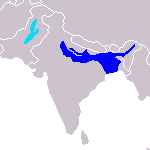Platanista
| Platanista | ||||||||||||
|---|---|---|---|---|---|---|---|---|---|---|---|---|

Ganges dolphin |
||||||||||||
| Systematics | ||||||||||||
|
||||||||||||
| Scientific name of the family | ||||||||||||
| Platanistidae | ||||||||||||
| JE Gray , 1846 | ||||||||||||
| Scientific name of the genus | ||||||||||||
| Platanista | ||||||||||||
| Wagler , 1830 |
Platanista (family Platanistidae) is a genus of toothed whales that is found in large rivers in the north of the Indian subcontinent . A distinction is made between two types, the actual Ganges dolphin ( Platanista gangetica ) in the Ganges - Brahmaputra system and the Indus dolphin ( Platanista minor ) in the Indus .
features
Platanista species have an elongated, slightly upwardly curved snout. They are two to three meters long, with females on average slightly larger than males and weighing up to a hundred kilograms. The dorsal fin is small and inconspicuous. In all of these traits, the Platanista species resemble the Amazon dolphin , although they are only distantly related to it.
The body color is dark gray; the bottom is a little lighter than the top. The eyes are missing a lens and are stunted. The dolphins can only make out differences in brightness with their eyes. The real orientation takes place via the echolocation. Apparently life in the muddy water has atrophied the sense of sight.
distribution
The Platanista species live in different river systems. The South Asian river dolphin inhabits the Ganges - Brahmaputra system in northeastern India and Bangladesh . The other species, the Indus dolphin, lives in the middle reaches of the Indus in central Pakistan . Their distribution was once probably much greater and also included numerous tributaries of the Indus.
Way of life
Platanista species are usually solitary. They have their offspring at the beginning of the Indian dry season. The only young is about 70 cm long and is suckled for a year. The food is fish and invertebrates dug out of the bottom sludge.
Systematics
Ganges and Indus dolphins were originally thought to be one species. In the 1970s, the idea of keeping them as separate species took hold. In 1998, in his widely accepted standard work, Marine Mammals of the World: Systematics and Distribution , Dale W. Rice concluded that there were no extensive morphological differences to justify separation. He reunited both as one species and led the Indus dolphin as a subspecies of the Ganges dolphin. However, other works such as Nowak 1999 or Wilson & Reeder 2005 list the two populations as separate species.
The Ganges dolphins represent their own family of toothed whales . With the other river dolphins, such as the Amazon river dolphins , they share a common habitat and morphological similarities that may have arisen through convergent evolution . In the past, the Ganges dolphins were sometimes classified together with the Amazon , La Plata and Chinese river dolphins into a separate family (Platanistidae) or superfamily (Platanistoidea), but this contradicts molecular genetic studies. Today the ganges dolphins are the only remnants of a whale line that was once common in several families. Phylogenetically , they form the sister group of a common taxon made up of river dolphins and dolphin-like species .
threat
Both Platanista species are endangered because they get caught in fishing nets again and again, restricted by sluices and dams and become sterile when poison is discharged into the rivers. Ganges dolphins are also caught in some regions; Their meat is considered worthless, but their oil is an aphrodisiac and the meat is used as bait when fishing for catfish . Both species are on the IUCN Red List .
literature
- DE Wilson and DM Reeder: Mammal Species of the World. Johns Hopkins University Press 2005, ISBN 0-8018-8221-4
- Ronald M. Nowak: Walker's Mammals of the World. Johns Hopkins University Press 1999, ISBN 0-8018-5789-9
- Bild der Wissenschaft, Expedition to the last river dolphins, edition 8/2007, p. 36ff
Web links
- Platanista gangetica in the endangered Red List species the IUCN 2006. Posted by: Smith & Braulik, 2004. Retrieved on 6 May, 2006.
- Year of the dolphin


